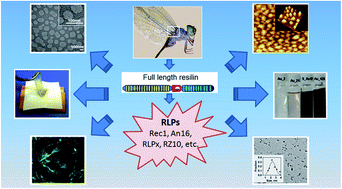Multi-responsive biomaterials and nanobioconjugates from resilin-like protein polymers
Abstract
Nature, through evolution over millions of years, has perfected materials with amazing characteristics and awe-inspiring functionalities that exceed the performance of man-made synthetic materials. One such remarkable material is native resilin – an extracellular skeletal protein that plays a major role in the jumping, flying, and sound production mechanisms in many insects. It is one of the most resilient (energy efficient) elastomeric biomaterials known with a resilience of ∼97% and a fatigue life in excess of 300 million cycles. Recently, resilin-like polypeptides (RLPs) with exquisite control over the amino acid sequence (comprising repeat resilin motifs) and tuneable biological properties and/or functions have been generated by genetic engineering and cloning techniques. RLPs have been the subject of intensive investigation over a decade and are now recognized to be multi-functional and multi-stimuli responsive; including temperature (exhibiting both an upper and a lower critical solution temperature), pH, moisture, ion and photo-responsive with tuneable photo-physical properties. Such unusual multi-stimuli responsiveness has scarcely been offered and reported for either synthetic or natural biopolymers. Furthermore, the directed molecular self-assembly property of RLPs also exhibits promise as efficient templates for the synthesis and stabilization of metal nanoparticles. These developments and observations reveal the opportunities and new challenges for RLPs as novel materials for nanotechnology, nanobiotechnology and therapeutic applications. In this review, we discuss and highlight the design and synthesis of different RLPs, their unique molecular architecture, advanced responsive behaviour, and functionality of hydrogels, solid–liquid interfaces, nanoparticles and nanobioconjugates derived from RLPs.


 Please wait while we load your content...
Please wait while we load your content...